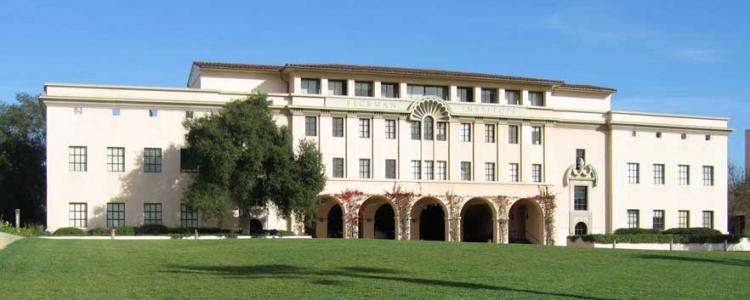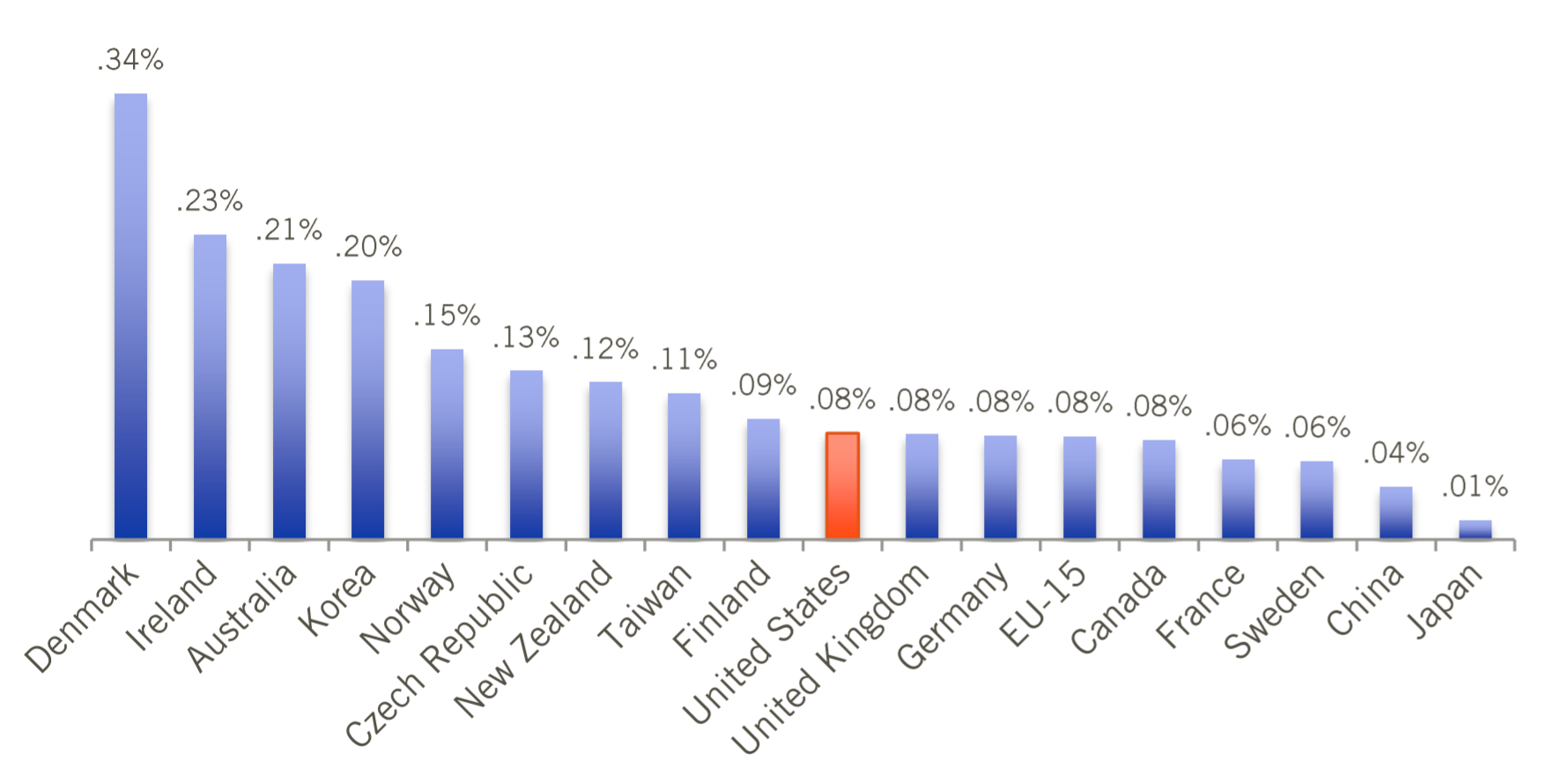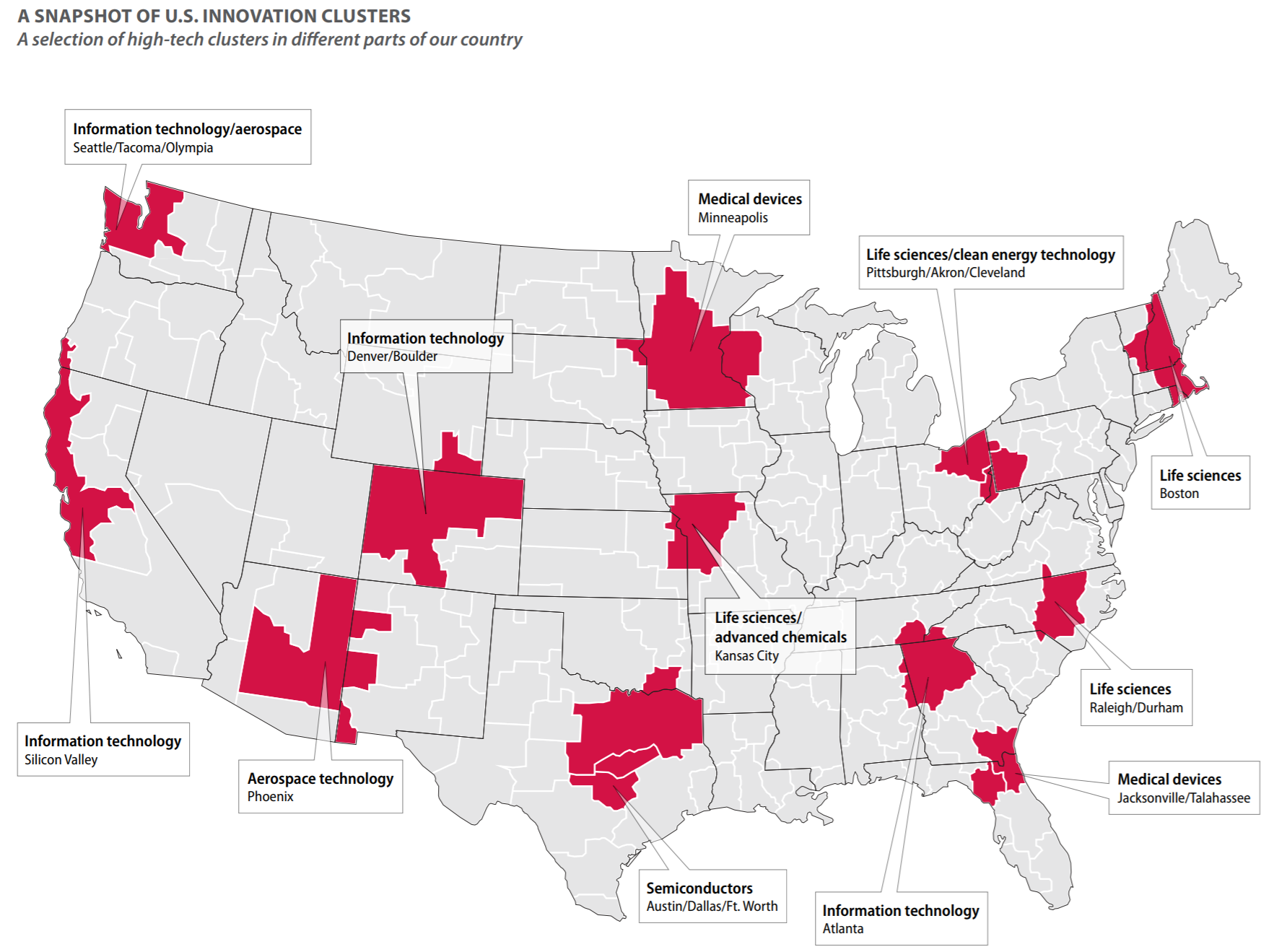Elements of the US National Innovation System, Part 2: Policies Applied for the Development of the Innovation Environment
The “success triangle of innovation” consists of a business environment, a regulatory environment and a policy applied by the state to develop an innovation environment. We considered the first two factors in the previous article . But they relate to the country's economy as a whole, they help to understand how business activities are organized, what companies have to pay for, how they can get tax breaks.
Today we will look at the methods that the US federal government and the municipal authorities of the country use to develop innovations directly, to increase the efficiency of commercialization of inventions and technologies, to adopt technologies and attract investments from other countries, to develop a collaboration between business and the academic environment.

California Institute of Technology
Research and technology
Support research in universities and research institutes
The American research support system is based on two fundamental aspects:
On R & D in 2013, the United States spent about 140 billion dollars. If we take the percentage of GDP spent on these goals in the US, it has been falling since the 1960s - since the height of the Cold War and the Lunar race - and over the years has lost 25%. Growth jumps in R & D funding costs are associated with the National Institutes of Health , which in the 1990s received twice the increased funding to fight cancer and other serious diseases, as well as the defense industry to respond to the terrorist threats of Iraq and Afghanistan.
Federal laboratories
The system of federal laboratories in the United States has an extensive network in all states. One part of the laboratories operates directly under the direction of state bodies, and the other is given to private operators. The largest laboratories are founded by the Ministries of Defense, Energy and Health.
A huge role in the innovation system is played by the United States Department of Defense Advanced Research Projects (DAPRA), although it does not belong to federal laboratories. It works with a variety of defense projects.

National Bio and Agro-Defense Facility, Kansas laboratory
University studies
The Ministry of Defense, the Ministry of Energy, and the National Institutes of Health support university research to achieve their own goals. On the other hand, the US National Science Foundation is responsible for the development of science and technology in the country through the provision of temporary grants to entrepreneurs, researchers, research centers for works of a different nature, and not to specific research. Some of the funds go to expensive scientific equipment and facilities in “shared centers” that scientists and engineers need, but are too expensive for individual researchers or a local group. However, university research funding for the percentage of US GDP remains behind many countries, most notably Denmark, Ireland, Australia, Korea, and Norway. The graph below shows the percentage of GDP that states spent on university research in 2000-2011.

Technology Transfer System
Until the 1980s, technology transfer from universities and federal laboratories to the commercial market did not have a systemic nature, systemic support from the federal authorities. Of course, the Massachusetts Institute of Technology and Stanford University have already worked with industry and created technology for the market. But this was due more likely to their policies, including working technoparks and the tight connection between the academic environment and business.
In 1980, Congress passed the Stevenson-Weidler Law on Technological Innovation , which required every federal laboratory to create an office to identify commercially valuable technologies and their subsequent transfer to the private sector. So the federal government decided to develop interaction between business and laboratories, for which the government is already spending money. And the Bay-Dole Act, adopted in the same year, gave universities the opportunity to independently earn on the results of their research. Until then, universities that received funding from the state could not manage the results of the research. This law The Economist called the most successful in the second half of the XX century, and The Wall Street Journal has included in the top three most effective measures for the development of innovation.
Enterprise research support
In the US, commercial activities are mainly conducted by private companies that are created for profit. The authorities generally do not directly support R & D in firms only if the research is not related to one of the state’s missions - for example, the defense industry.
Nevertheless, the federal government supports a number of policy measures that help create innovation in companies. In 1981, Congress established a tax credit for firms to stimulate research and development at a rate of 20%. In 1984, The Small Business Innovation Research was launched, for which federal agencies were required to allocate a share of their R & D budgets for small business research.
Knowledge movement system
Innovative Clusters
In 1977, the Italian scientist J. Bekattini introduced the term “industrial district”: it is “a local system with active cooperation between people and the primary industry, consisting of small independent firms specializing in various stages of a single production process”. "Marshallian industrial areas," according to the scientist, are naturally or historically limited territories, characterized by the presence and interpenetration of a community of people, and the production apparatus.
In the 1990s, a professor at Harvard Business School popularized the notion of a cluster : “A cluster is a group of close, geographically interrelated companies and their collaborating organizations that work together in a particular type of business, characterized by common activities and complementary ones. Clusters create the basis for the inflow of investments in small business, enable entrepreneurs to use the processes of diversification.
The effectiveness of cluster development shows areas such as Silicon Valley and the Research Triangle of North Carolina, which we discussed in the article Technoparks of Russia and the world . Nevertheless, the US federal government played a minor role in the development of innovative clusters. Instead, the regions are doing this, developing appropriate support programs.

Industry Collaboration System (with academic and research institutes)
Universities - Massachusetts Technology, California Technology, Stanford - are actively working with the business. But for each of these universities there are a dozen, in which they work with innovations much less efficiently. Over the years, the best universities have developed interaction between business and students and professors. The absence of a strict hierarchy plays its role: you do not need to be a professor twice to create a new technology and get support in its commercialization.
Organizations such as the Network of Engineering Research Centers (Engineering Research Centers), opened by the National Science Foundation, and the Industry / University Cooperative Research Center (I / UCRC) participate in the collaboration between universities and business.
Acquisition of foreign technology and export of American
The US market is huge, and in some areas the country is at the forefront of development. At the same time, the USA sometimes implements political measures for obtaining foreign technologies. For example, welcomes foreign direct investment. In the 1980s and 1990s, the federal government actively attracted investment from Japanese car manufacturers. In many ways, this was done to obtain jobs within the country, which was trying to recover from the crisis of the 1970s. But also the goal was to study the Japanese production system.
The US Department of Commerce is working with states to try to increase their investment attractiveness and attract investment through the Select USA program. A committee on foreign investment in the United States monitors the acquisition of American technology by foreign companies in order to identify both their economic effect and the absence of a threat to national security.
Human capital
Higher education system
Some universities and colleges are state-managed, some are managed and funded through paid tuition and charitable donations. Some students can afford to pay tuition, others receive financial assistance from universities. States reduce education grants. This is attributed to the fact that the United States lags behind many other countries in terms of students enrolled in higher education institutions.
The federal government is not very concerned about the graduation of students in certain specialties, basically it leaves their choice to the will of the market. But this leads to a shortage of specialists in the field of science, technology and mathematics. To correct this problem, the state can use a massive online course program.
Skills training, advanced training
In the United States, employers had previously played an active role in teaching employees new skills and advanced training. Now there is no single national system in the country - employers have been saving on it for the last thirty years. Individual programs operate at the state level.
Wisconsin and Georgia have youth education programs. In some states, there are “career academies” in high schools. In Michigan, on a competitive basis, they issue grants and provide technical support to start-ups that have grown up in 25 industrial alliances.
In Pennsylvania, the Industrial Partner Program, with a budget of 15 million US dollars, is designed to ensure that employers and workers work together in the same cluster to fight personnel hunger in the industry. In some states, employers can save on taxes if they spend money on raising the skills of workers. For example, in Rhode Island, firms can spend 50% of the money spent on training employees to pay corporate taxes.
The main component of the system of training skills in the United States is a Community College or "community college" - a type of colleges, created in order to make higher education more accessible to the US population. Such colleges are notable for low cost of education and convenient location in cities. Students are comfortable working, follow the family.

Migration policy
The United States of America more than other countries rely on highly skilled migrants to support the innovation system. At least seven studies examined the role of migrants in launching new companies: they are key players in the process from 15% to 26% of new companies in the high-tech sector of the United States over the past twenty years. They opened 40% of firms based in California and New Jersey from 1995 to 2005.
US federal authorities encourage migration by providing permanent residence and a temporary work visa for which the employer pays. The country continues to work to facilitate the path to citizenship for migrants.
While the strategy of national innovation policy is in Germany, Sweden, Finland, there is no uniform coordinated policy in the United States in this direction. This reflects the view that innovations should be left to the will of the market, and that the role of the state in them lies mainly in supporting the education system.
Today we will look at the methods that the US federal government and the municipal authorities of the country use to develop innovations directly, to increase the efficiency of commercialization of inventions and technologies, to adopt technologies and attract investments from other countries, to develop a collaboration between business and the academic environment.

California Institute of Technology
Policies applied to the development of the innovation environment
Research and technology
Support research in universities and research institutes
The American research support system is based on two fundamental aspects:
- Support for research related to the state’s mission — defense, health — through federal laboratories.
- Support for all other research mainly through funding universities.
On R & D in 2013, the United States spent about 140 billion dollars. If we take the percentage of GDP spent on these goals in the US, it has been falling since the 1960s - since the height of the Cold War and the Lunar race - and over the years has lost 25%. Growth jumps in R & D funding costs are associated with the National Institutes of Health , which in the 1990s received twice the increased funding to fight cancer and other serious diseases, as well as the defense industry to respond to the terrorist threats of Iraq and Afghanistan.
Federal laboratories
The system of federal laboratories in the United States has an extensive network in all states. One part of the laboratories operates directly under the direction of state bodies, and the other is given to private operators. The largest laboratories are founded by the Ministries of Defense, Energy and Health.
A huge role in the innovation system is played by the United States Department of Defense Advanced Research Projects (DAPRA), although it does not belong to federal laboratories. It works with a variety of defense projects.

National Bio and Agro-Defense Facility, Kansas laboratory
University studies
The Ministry of Defense, the Ministry of Energy, and the National Institutes of Health support university research to achieve their own goals. On the other hand, the US National Science Foundation is responsible for the development of science and technology in the country through the provision of temporary grants to entrepreneurs, researchers, research centers for works of a different nature, and not to specific research. Some of the funds go to expensive scientific equipment and facilities in “shared centers” that scientists and engineers need, but are too expensive for individual researchers or a local group. However, university research funding for the percentage of US GDP remains behind many countries, most notably Denmark, Ireland, Australia, Korea, and Norway. The graph below shows the percentage of GDP that states spent on university research in 2000-2011.

Technology Transfer System
Until the 1980s, technology transfer from universities and federal laboratories to the commercial market did not have a systemic nature, systemic support from the federal authorities. Of course, the Massachusetts Institute of Technology and Stanford University have already worked with industry and created technology for the market. But this was due more likely to their policies, including working technoparks and the tight connection between the academic environment and business.
In 1980, Congress passed the Stevenson-Weidler Law on Technological Innovation , which required every federal laboratory to create an office to identify commercially valuable technologies and their subsequent transfer to the private sector. So the federal government decided to develop interaction between business and laboratories, for which the government is already spending money. And the Bay-Dole Act, adopted in the same year, gave universities the opportunity to independently earn on the results of their research. Until then, universities that received funding from the state could not manage the results of the research. This law The Economist called the most successful in the second half of the XX century, and The Wall Street Journal has included in the top three most effective measures for the development of innovation.
Enterprise research support
In the US, commercial activities are mainly conducted by private companies that are created for profit. The authorities generally do not directly support R & D in firms only if the research is not related to one of the state’s missions - for example, the defense industry.
Nevertheless, the federal government supports a number of policy measures that help create innovation in companies. In 1981, Congress established a tax credit for firms to stimulate research and development at a rate of 20%. In 1984, The Small Business Innovation Research was launched, for which federal agencies were required to allocate a share of their R & D budgets for small business research.
Knowledge movement system
Innovative Clusters
In 1977, the Italian scientist J. Bekattini introduced the term “industrial district”: it is “a local system with active cooperation between people and the primary industry, consisting of small independent firms specializing in various stages of a single production process”. "Marshallian industrial areas," according to the scientist, are naturally or historically limited territories, characterized by the presence and interpenetration of a community of people, and the production apparatus.
In the 1990s, a professor at Harvard Business School popularized the notion of a cluster : “A cluster is a group of close, geographically interrelated companies and their collaborating organizations that work together in a particular type of business, characterized by common activities and complementary ones. Clusters create the basis for the inflow of investments in small business, enable entrepreneurs to use the processes of diversification.
The effectiveness of cluster development shows areas such as Silicon Valley and the Research Triangle of North Carolina, which we discussed in the article Technoparks of Russia and the world . Nevertheless, the US federal government played a minor role in the development of innovative clusters. Instead, the regions are doing this, developing appropriate support programs.

Industry Collaboration System (with academic and research institutes)
Universities - Massachusetts Technology, California Technology, Stanford - are actively working with the business. But for each of these universities there are a dozen, in which they work with innovations much less efficiently. Over the years, the best universities have developed interaction between business and students and professors. The absence of a strict hierarchy plays its role: you do not need to be a professor twice to create a new technology and get support in its commercialization.
Organizations such as the Network of Engineering Research Centers (Engineering Research Centers), opened by the National Science Foundation, and the Industry / University Cooperative Research Center (I / UCRC) participate in the collaboration between universities and business.
Acquisition of foreign technology and export of American
The US market is huge, and in some areas the country is at the forefront of development. At the same time, the USA sometimes implements political measures for obtaining foreign technologies. For example, welcomes foreign direct investment. In the 1980s and 1990s, the federal government actively attracted investment from Japanese car manufacturers. In many ways, this was done to obtain jobs within the country, which was trying to recover from the crisis of the 1970s. But also the goal was to study the Japanese production system.
The US Department of Commerce is working with states to try to increase their investment attractiveness and attract investment through the Select USA program. A committee on foreign investment in the United States monitors the acquisition of American technology by foreign companies in order to identify both their economic effect and the absence of a threat to national security.
Human capital
Higher education system
Some universities and colleges are state-managed, some are managed and funded through paid tuition and charitable donations. Some students can afford to pay tuition, others receive financial assistance from universities. States reduce education grants. This is attributed to the fact that the United States lags behind many other countries in terms of students enrolled in higher education institutions.
The federal government is not very concerned about the graduation of students in certain specialties, basically it leaves their choice to the will of the market. But this leads to a shortage of specialists in the field of science, technology and mathematics. To correct this problem, the state can use a massive online course program.
Skills training, advanced training
In the United States, employers had previously played an active role in teaching employees new skills and advanced training. Now there is no single national system in the country - employers have been saving on it for the last thirty years. Individual programs operate at the state level.
Wisconsin and Georgia have youth education programs. In some states, there are “career academies” in high schools. In Michigan, on a competitive basis, they issue grants and provide technical support to start-ups that have grown up in 25 industrial alliances.
In Pennsylvania, the Industrial Partner Program, with a budget of 15 million US dollars, is designed to ensure that employers and workers work together in the same cluster to fight personnel hunger in the industry. In some states, employers can save on taxes if they spend money on raising the skills of workers. For example, in Rhode Island, firms can spend 50% of the money spent on training employees to pay corporate taxes.
The main component of the system of training skills in the United States is a Community College or "community college" - a type of colleges, created in order to make higher education more accessible to the US population. Such colleges are notable for low cost of education and convenient location in cities. Students are comfortable working, follow the family.

Migration policy
The United States of America more than other countries rely on highly skilled migrants to support the innovation system. At least seven studies examined the role of migrants in launching new companies: they are key players in the process from 15% to 26% of new companies in the high-tech sector of the United States over the past twenty years. They opened 40% of firms based in California and New Jersey from 1995 to 2005.
US federal authorities encourage migration by providing permanent residence and a temporary work visa for which the employer pays. The country continues to work to facilitate the path to citizenship for migrants.
General innovation policy
While the strategy of national innovation policy is in Germany, Sweden, Finland, there is no uniform coordinated policy in the United States in this direction. This reflects the view that innovations should be left to the will of the market, and that the role of the state in them lies mainly in supporting the education system.
All Articles